Peter Bell
Language Bias in Self-Supervised Learning For Automatic Speech Recognition
Jan 31, 2025



Abstract:Self-supervised learning (SSL) is used in deep learning to train on large datasets without the need for expensive labelling of the data. Recently, large Automatic Speech Recognition (ASR) models such as XLS-R have utilised SSL to train on over one hundred different languages simultaneously. However, deeper investigation shows that the bulk of the training data for XLS-R comes from a small number of languages. Biases learned through SSL have been shown to exist in multiple domains, but language bias in multilingual SSL ASR has not been thoroughly examined. In this paper, we utilise the Lottery Ticket Hypothesis (LTH) to identify language-specific subnetworks within XLS-R and test the performance of these subnetworks on a variety of different languages. We are able to show that when fine-tuning, XLS-R bypasses traditional linguistic knowledge and builds only on weights learned from the languages with the largest data contribution to the pretraining data.
Beyond Oversmoothing: Evaluating DDPM and MSE for Scalable Speech Synthesis in ASR
Oct 16, 2024


Abstract:Synthetically generated speech has rapidly approached human levels of naturalness. However, the paradox remains that ASR systems, when trained on TTS output that is judged as natural by humans, continue to perform badly on real speech. In this work, we explore whether this phenomenon is due to the oversmoothing behaviour of models commonly used in TTS, with a particular focus on the behaviour of TTS-for-ASR as the amount of TTS training data is scaled up. We systematically compare Denoising Diffusion Probabilistic Models (DDPM) to Mean Squared Error (MSE) based models for TTS, when used for ASR model training. We test the scalability of the two approaches, varying both the number hours, and the number of different speakers. We find that for a given model size, DDPM can make better use of more data, and a more diverse set of speakers, than MSE models. We achieve the best reported ratio between real and synthetic speech WER to date (1.46), but also find that a large gap remains.
Semi-Supervised Cognitive State Classification from Speech with Multi-View Pseudo-Labeling
Sep 25, 2024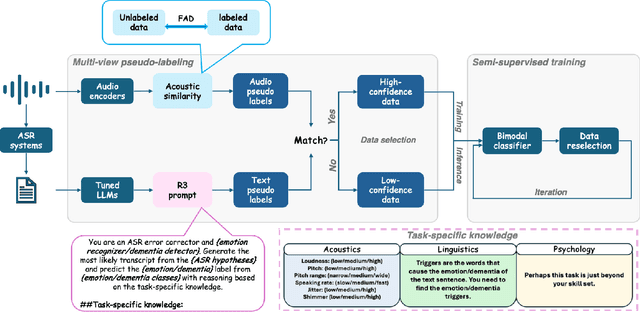
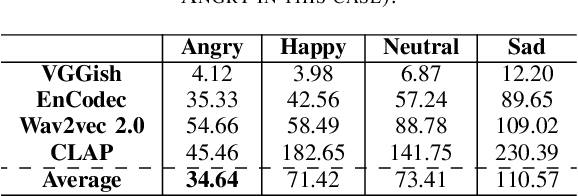

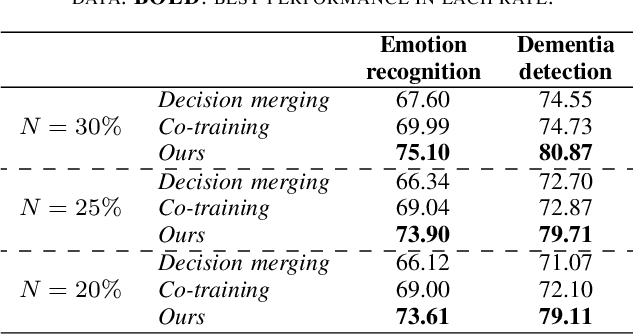
Abstract:The lack of labeled data is a common challenge in speech classification tasks, particularly those requiring extensive subjective assessment, such as cognitive state classification. In this work, we propose a Semi-Supervised Learning (SSL) framework, introducing a novel multi-view pseudo-labeling method that leverages both acoustic and linguistic characteristics to select the most confident data for training the classification model. Acoustically, unlabeled data are compared to labeled data using the Frechet audio distance, calculated from embeddings generated by multiple audio encoders. Linguistically, large language models are prompted to revise automatic speech recognition transcriptions and predict labels based on our proposed task-specific knowledge. High-confidence data are identified when pseudo-labels from both sources align, while mismatches are treated as low-confidence data. A bimodal classifier is then trained to iteratively label the low-confidence data until a predefined criterion is met. We evaluate our SSL framework on emotion recognition and dementia detection tasks. Experimental results demonstrate that our method achieves competitive performance compared to fully supervised learning using only 30% of the labeled data and significantly outperforms two selected baselines.
Large Language Model Based Generative Error Correction: A Challenge and Baselines for Speech Recognition, Speaker Tagging, and Emotion Recognition
Sep 17, 2024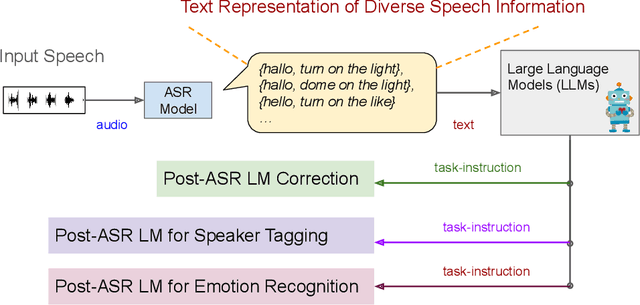
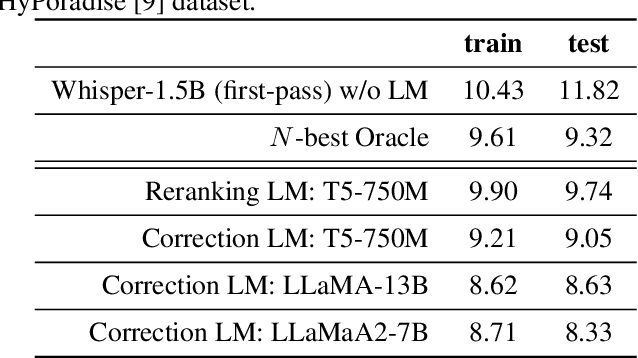
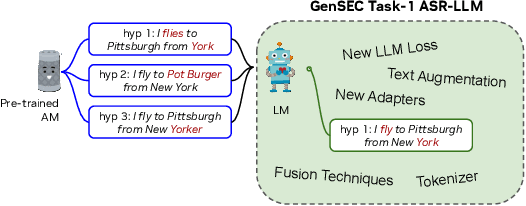
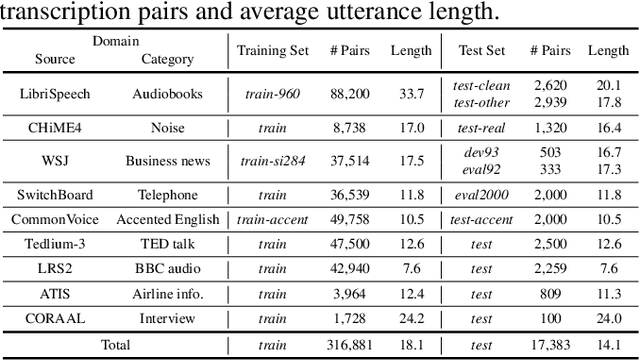
Abstract:Given recent advances in generative AI technology, a key question is how large language models (LLMs) can enhance acoustic modeling tasks using text decoding results from a frozen, pretrained automatic speech recognition (ASR) model. To explore new capabilities in language modeling for speech processing, we introduce the generative speech transcription error correction (GenSEC) challenge. This challenge comprises three post-ASR language modeling tasks: (i) post-ASR transcription correction, (ii) speaker tagging, and (iii) emotion recognition. These tasks aim to emulate future LLM-based agents handling voice-based interfaces while remaining accessible to a broad audience by utilizing open pretrained language models or agent-based APIs. We also discuss insights from baseline evaluations, as well as lessons learned for designing future evaluations.
TTSDS -- Text-to-Speech Distribution Score
Jul 17, 2024Abstract:Many recently published Text-to-Speech (TTS) systems produce audio close to real speech. However, TTS evaluation needs to be revisited to make sense of the results obtained with the new architectures, approaches and datasets. We propose evaluating the quality of synthetic speech as a combination of multiple factors such as prosody, speaker identity, and intelligibility. Our approach assesses how well synthetic speech mirrors real speech by obtaining correlates of each factor and measuring their distance from both real speech datasets and noise datasets. We benchmark 35 TTS systems developed between 2008 and 2024 and show that our score computed as an unweighted average of factors strongly correlates with the human evaluations from each time period.
Speech Emotion Recognition with ASR Transcripts: A Comprehensive Study on Word Error Rate and Fusion Techniques
Jun 12, 2024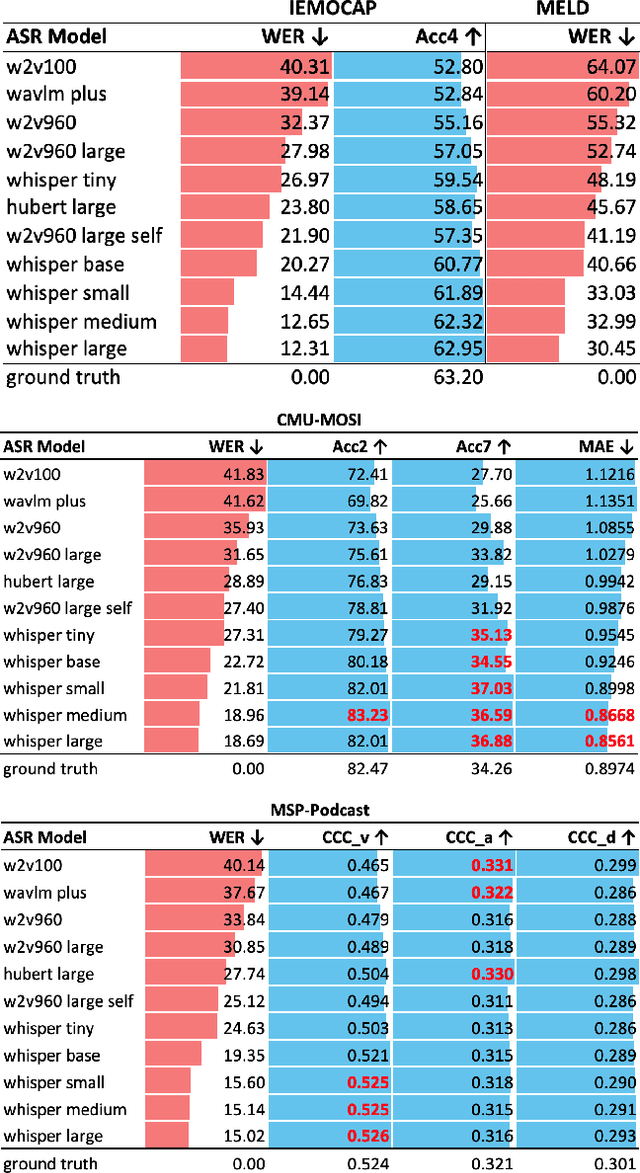

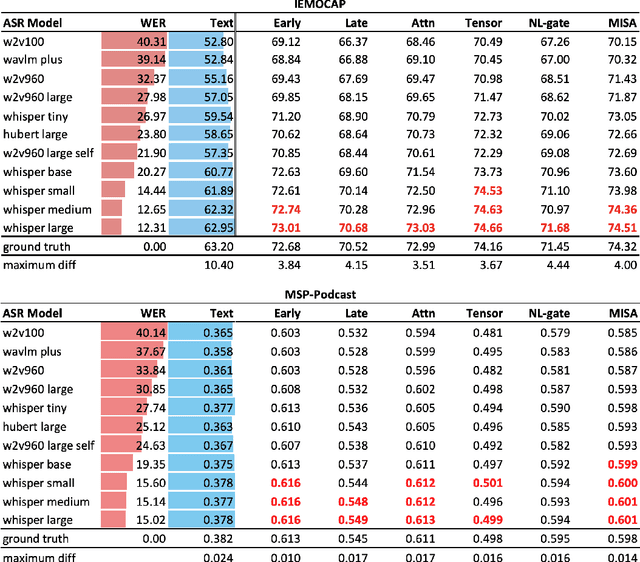
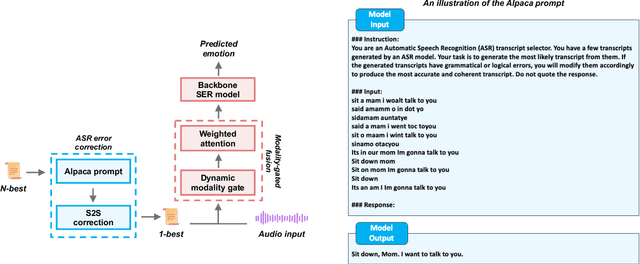
Abstract:Text data is commonly utilized as a primary input to enhance Speech Emotion Recognition (SER) performance and reliability. However, the reliance on human-transcribed text in most studies impedes the development of practical SER systems, creating a gap between in-lab research and real-world scenarios where Automatic Speech Recognition (ASR) serves as the text source. Hence, this study benchmarks SER performance using ASR transcripts with varying Word Error Rates (WERs) on well-known corpora: IEMOCAP, CMU-MOSI, and MSP-Podcast. Our evaluation includes text-only and bimodal SER with diverse fusion techniques, aiming for a comprehensive analysis that uncovers novel findings and challenges faced by current SER research. Additionally, we propose a unified ASR error-robust framework integrating ASR error correction and modality-gated fusion, achieving lower WER and higher SER results compared to the best-performing ASR transcript. This research is expected to provide insights into SER with ASR assistance, especially for real-world applications.
Phonetic Error Analysis of Raw Waveform Acoustic Models with Parametric and Non-Parametric CNNs
Jun 02, 2024
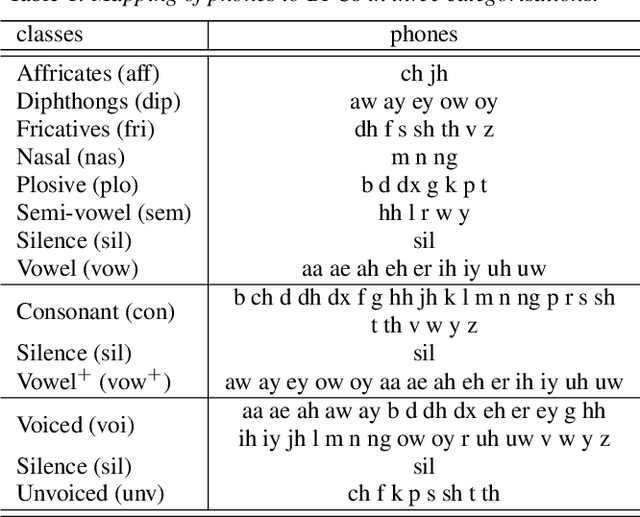
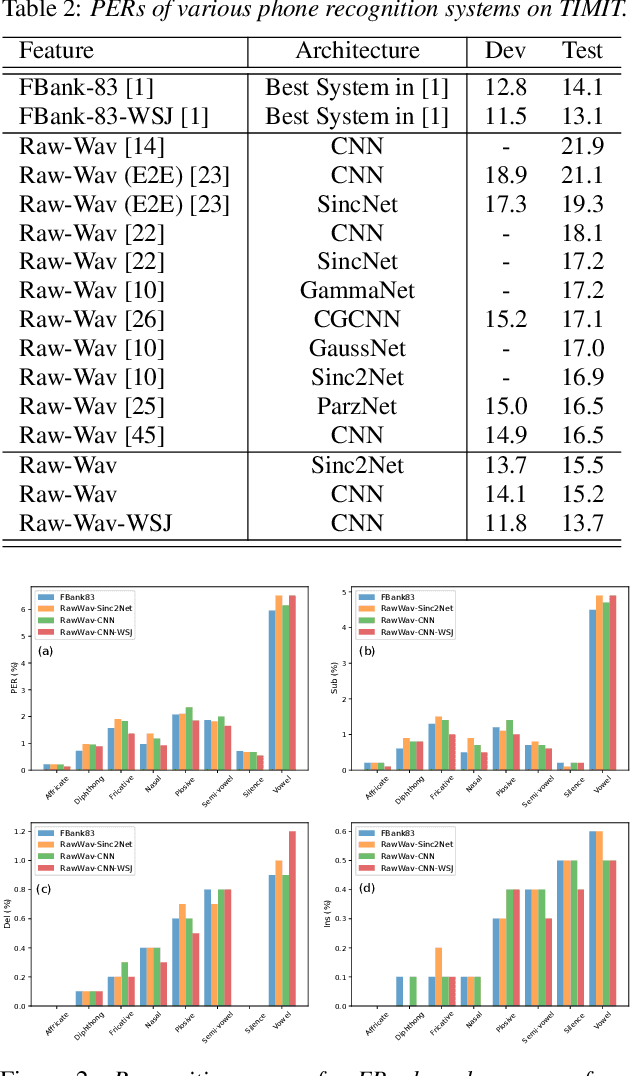

Abstract:In this paper, we analyse the error patterns of the raw waveform acoustic models in TIMIT's phone recognition task. Our analysis goes beyond the conventional phone error rate (PER) metric. We categorise the phones into three groups: {affricate, diphthong, fricative, nasal, plosive, semi-vowel, vowel, silence}, {consonant, vowel+, silence}, and {voiced, unvoiced, silence} and, compute the PER for each broad phonetic class in each category. We also construct a confusion matrix for each category using the substitution errors and compare the confusion patterns with those of the Filterbank and Wav2vec 2.0 systems. Our raw waveform acoustic models consists of parametric (Sinc2Net) or non-parametric CNNs and Bidirectional LSTMs, achieving down to 13.7%/15.2% PERs on TIMIT Dev/Test sets, outperforming reported PERs for raw waveform models in the literature. We also investigate the impact of transfer learning from WSJ on the phonetic error patterns and confusion matrices. It reduces the PER to 11.8%/13.7% on the Dev/Test sets.
1st Place Solution to Odyssey Emotion Recognition Challenge Task1: Tackling Class Imbalance Problem
May 30, 2024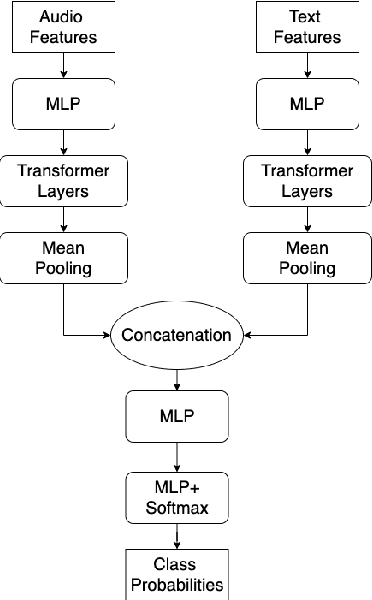



Abstract:Speech emotion recognition is a challenging classification task with natural emotional speech, especially when the distribution of emotion types is imbalanced in the training and test data. In this case, it is more difficult for a model to learn to separate minority classes, resulting in those sometimes being ignored or frequently misclassified. Previous work has utilised class weighted loss for training, but problems remain as it sometimes causes over-fitting for minor classes or under-fitting for major classes. This paper presents the system developed by a multi-site team for the participation in the Odyssey 2024 Emotion Recognition Challenge Track-1. The challenge data has the aforementioned properties and therefore the presented systems aimed to tackle these issues, by introducing focal loss in optimisation when applying class weighted loss. Specifically, the focal loss is further weighted by prior-based class weights. Experimental results show that combining these two approaches brings better overall performance, by sacrificing performance on major classes. The system further employs a majority voting strategy to combine the outputs of an ensemble of 7 models. The models are trained independently, using different acoustic features and loss functions - with the aim to have different properties for different data. Hence these models show different performance preferences on major classes and minor classes. The ensemble system output obtained the best performance in the challenge, ranking top-1 among 68 submissions. It also outperformed all single models in our set. On the Odyssey 2024 Emotion Recognition Challenge Task-1 data the system obtained a Macro-F1 score of 35.69% and an accuracy of 37.32%.
Explainable Attribute-Based Speaker Verification
May 30, 2024Abstract:This paper proposes a fully explainable approach to speaker verification (SV), a task that fundamentally relies on individual speaker characteristics. The opaque use of speaker attributes in current SV systems raises concerns of trust. Addressing this, we propose an attribute-based explainable SV system that identifies speakers by comparing personal attributes such as gender, nationality, and age extracted automatically from voice recordings. We believe this approach better aligns with human reasoning, making it more understandable than traditional methods. Evaluated on the Voxceleb1 test set, the best performance of our system is comparable with the ground truth established when using all correct attributes, proving its efficacy. Whilst our approach sacrifices some performance compared to non-explainable methods, we believe that it moves us closer to the goal of transparent, interpretable AI and lays the groundwork for future enhancements through attribute expansion.
Crossmodal ASR Error Correction with Discrete Speech Units
May 26, 2024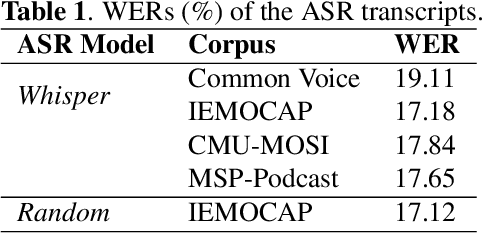
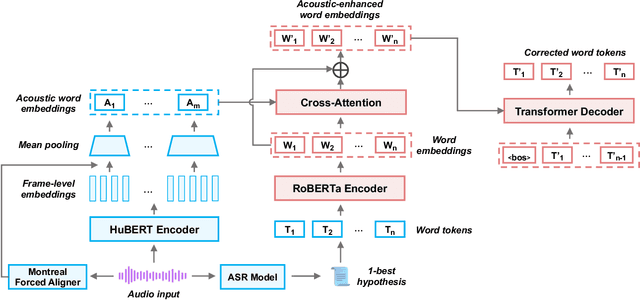

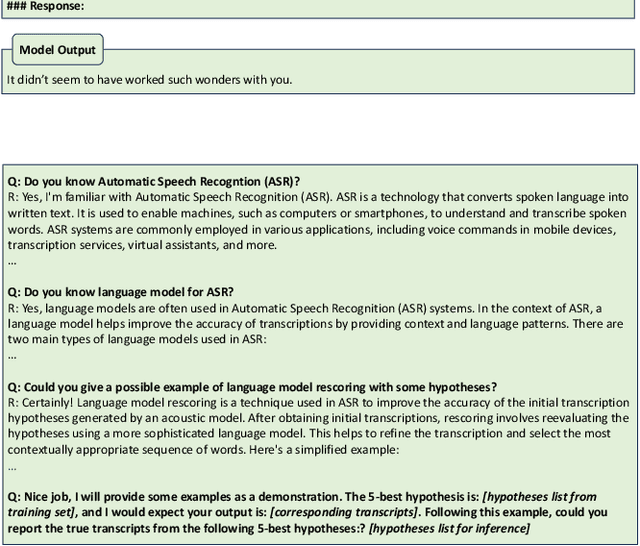
Abstract:ASR remains unsatisfactory in scenarios where the speaking style diverges from that used to train ASR systems, resulting in erroneous transcripts. To address this, ASR Error Correction (AEC), a post-ASR processing approach, is required. In this work, we tackle an understudied issue: the Low-Resource Out-of-Domain (LROOD) problem, by investigating crossmodal AEC on very limited downstream data with 1-best hypothesis transcription. We explore pre-training and fine-tuning strategies and uncover an ASR domain discrepancy phenomenon, shedding light on appropriate training schemes for LROOD data. Moreover, we propose the incorporation of discrete speech units to align with and enhance the word embeddings for improving AEC quality. Results from multiple corpora and several evaluation metrics demonstrate the feasibility and efficacy of our proposed AEC approach on LROOD data, as well as its generalizability and superiority on large-scale data. Finally, a study on speech emotion recognition confirms that our model produces ASR error-robust transcripts suitable for downstream applications.
 Add to Chrome
Add to Chrome Add to Firefox
Add to Firefox Add to Edge
Add to Edge